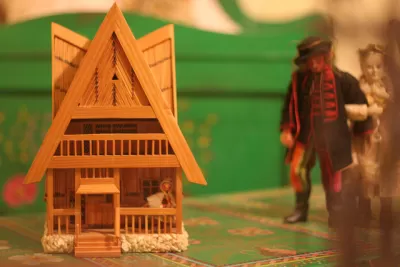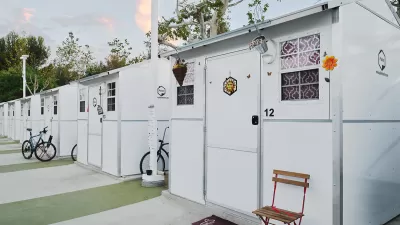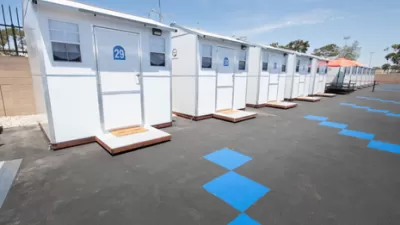Imagine if hosting a transitional tiny home village for the homeless became the norm for all suitable vacant land?

Last time I was in Atlanta, I stayed near a spot where dozens, probably hundreds, of homeless people would congregate on the sidewalks in a couple block radius around a center that served their needs. There we many things striking about this, but I remember one of the things that bothered me was the two large empty lots on the corner, which had signs on them expressly forbidding entrance or camping. One still had the foundation of a previous building, so though totally open to the sky, it still would have been a mildly sheltered and slightly more private place to be. Since the lots weren’t fenced off, and yet were empty, while the sidewalks were crowded, I had to assume that those signs were backed up by aggressive enforcement. Yuck.
Some folks in Denver are trying to do a little better. At the Intersections conference last month, the Urban Land Conservancy (ULC) and design group Radian, gave a brief presentation in the Ignite pitch session on the Beloved Community village. Beloved Community is a self-governed tiny home village for those transitioning out of homelessness, especially those not served by the shelter system. People with pets, couples, transgender folks, and people trying to stay sober, for example, can all find themselves either not welcome or not safe in shelters, and are therefore among the priorities for acceptance into the Beloved Community village. Various organizations provide supportive services to the residents, who share the work of maintaining the community.
ULC has some land that they will be building permanently affordable housing on—but that for now is sitting vacant while the predevelopment work happens. ULC director Aaron Miripol said that while ULC’s work aims to reduce the housing crisis over the long term by increasing affordable housing, there is also the very immediate question of what to do for people who are homeless now. As we’ve written about before, tiny home villages are one life-saving answer to that question. But they need somewhere to be.
FULL STORY: Tiny Homes for the Homeless—Would You Host a Village?

Planetizen Federal Action Tracker
A weekly monitor of how Trump’s orders and actions are impacting planners and planning in America.

San Francisco's School District Spent $105M To Build Affordable Housing for Teachers — And That's Just the Beginning
SFUSD joins a growing list of school districts using their land holdings to address housing affordability challenges faced by their own employees.

The Tiny, Adorable $7,000 Car Turning Japan Onto EVs
The single seat Mibot charges from a regular plug as quickly as an iPad, and is about half the price of an average EV.

San Diego Votes to Rein in “Towering” ADUs
City council voted to limit the number of units in accessory buildings to six — after confronting backyard developments of up to 100 units behind a single family home.

Texas Legislature’s Surprising Pro-Housing Swing
Smaller homes on smaller lots, office to apartment conversions, and 40% less say for NIMBYs, vote state lawmakers.

Even Edmonton Wants Single Staircase Buildings
Canada's second most affordable major city joins those angling to nix the requirement for two staircases in multi-family buildings.
Urban Design for Planners 1: Software Tools
This six-course series explores essential urban design concepts using open source software and equips planners with the tools they need to participate fully in the urban design process.
Planning for Universal Design
Learn the tools for implementing Universal Design in planning regulations.
Borough of Carlisle
Smith Gee Studio
City of Camden Redevelopment Agency
City of Astoria
Transportation Research & Education Center (TREC) at Portland State University
City of Camden Redevelopment Agency
Municipality of Princeton (NJ)





























